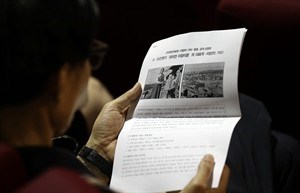
A South Korean filmgoer looks at the leaflet of South Korean movie "The Street of the Sun,” during its first screening in six decades at Korean Film Archive in Seoul, South Korea, Tuesday, June 25, 2013. The only surviving Korean War-era South Korean film by director Min Kyoung-sik, got the screening Tuesday, the 63rd anniversary of the beginning of the war. Now digitally restored, it offers South Koreans a rare glimpse at how their ancestors lived amid the destruction and poverty of war. The movie was the debut feature of Min, a South Korean director who took a camera to the streets of Daegu in 1952, while a stream of refugees poured in. (AP Photo/Lee Jin-man)
June 25, 2013 - 4:10 AM
SEOUL, South Korea - For decades, South Korean film buffs thought all their country's moviemaking from the Korean War era was lost forever. And it would have been, but for one film wrapped in a cocoon of old newspapers, tucked inside a plastic bag and placed in a dark, dusty closet.
That film, "The Street of the Sun," got its first screening in six decades Tuesday, the 63th anniversary of the beginning of the war. Now digitally restored, it offers South Koreans a rare glimpse at how their ancestors lived amid the destruction and poverty of war.
The movie was the debut feature of Min Kyoung-sik, a South Korean director who took a camera to the streets of Daegu in 1952, while a stream of refugees poured in. The southeastern city was tucked behind a perimeter secured by U.S. and South Korean forces battling North Korea and China to the north.
The film's sentimental story of a refugee schoolteacher who becomes a surrogate father figure for street urchins attempts to teach a social lesson about wartime poverty and crime.
While fiction, it offers a look at real life in war-torn South Korea. The actors and producers had been uprooted by fighting, and many of the scenes reflect the city's actual surroundings rather than a movie set, with non-actors in the mix.
The war started June 25, 1950, and ended in a truce a year after the film was made. The Koreas remain technically at war, separated by a heavily fortified border, and about 28,500 U.S. troops are still stationed in the South.
Min's movie was long believed to have been destroyed or lost, along with the 13 other South Korean films made during the war, according to the Korean Film Archive, the organization behind the film's restoration. But two decades ago, the director's daughter-in-law, Seong Ryeong-chul, found the 62-minute, 16 mm film in a closet at her home.
Seong said in an interview that she nearly threw away the coil of negatives. "But when I raised the plastic ribbon against the light, I saw tiny images of people etched inside," she said.
Even after the discovery, well over a decade passed before the Korean Film Archive became aware of the film. Seong contacted the organization in 2009, and in 2012 she granted the film to the archive for an undisclosed fee. The audio has never been found, so the film was screened Tuesday without sound.
The story begins at a train station where a Seoul schoolteacher arrives at the scene of a fight. He watches a local break up the brawl between two men. Another scene depicts a dusty road in wartime Daegu lined with thatched roof houses that form a shantytown around the original city.
The influences of American culture prevail over the scenes. Refugee children play baseball in clothing straight out of 1950s American comic strips.
Civilian life behind the U.S.-South Korean perimeter is depicted as impoverished but peaceful: Children bend vines in an apple orchard and swim together in a creek where they learn to stop fighting and get along. Though they watch their elders struggle to make ends meet, there are no obvious references to war in the film.
Chung Chong-hwa of the film archive said the film shows the influence of post-World War II Italian classics like "The Bicycle Thief" in South Korean cinema at a time when war, poverty and desperation marked everyday life.
Chung said the style of "The Street of the Sun" influenced other filmmakers, including prolific South Korean director and producer Shin Sang-ok. Shin was kidnapped in 1978 by Kim Jong Il, son and eventual successor of North Korean leader Kim Il Sung, and spent years making movies for the cinephile and future dictator before escaping with his wife.
Min, who made five films in a relatively low-key career, had a life story that reflects the divisions that still haunt the two Koreas. Min's son, Min Byoung-hak, said Tuesday that the director's younger brother, Min Jung-sik, was on the north side of the 38th parallel when the Koreas were divided, and ended up making propagandistic films for the Pyongyang government.
Even in South Korea, which was led by military dictators for decades, filmmakers were often prevented from making the films they wanted to make as late as the 1990s, according to Darcy Paquet, founder of Koreanfilm.org.
South Korean film directors are now a growing presence on the international film festival circuit. The modern South Korean classic "Old Boy" was remade by U.S. film director Spike Lee and will be released this fall.
News from © The Associated Press, 2013